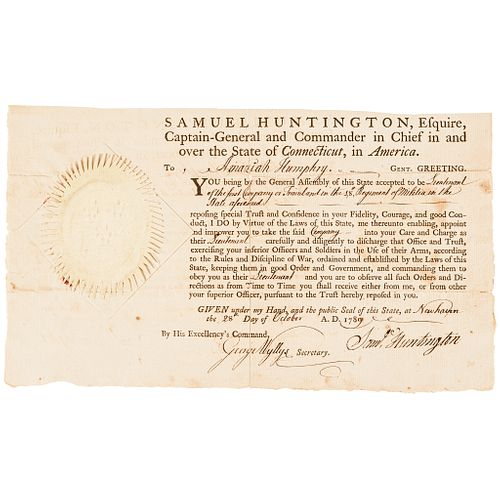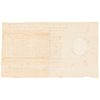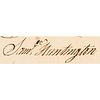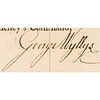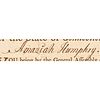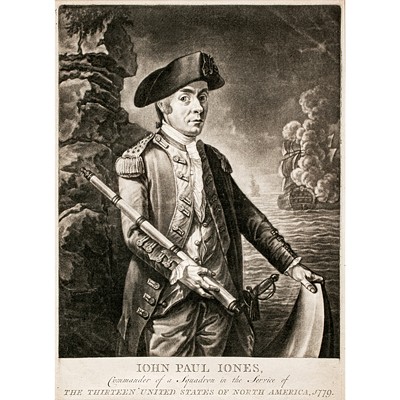SAMUEL HUNTINGTON, Ct. Governor, Decl. Signer + Continental Congress President
Lot 28
Categories
Estimate:
$1,000 - $1,500
Absentee vs Live bid
Two ways to bid:
- Leave a max absentee bid and the platform will bid on your behalf up to your maximum bid during the live auction.
- Bid live during the auction and your bids will be submitted real-time to the auctioneer.
Bid Increments
| Price | Bid Increment |
|---|---|
| $0 | $10 |
| $200 | $20 |
| $300 | $25 |
| $500 | $50 |
| $1,000 | $100 |
| $2,000 | $200 |
| $3,000 | $250 |
| $5,000 | $500 |
| $10,000 | $1,000 |
| $20,000 | $2,000 |
| $30,000 | $2,500 |
| $50,000 | $5,000 |
| $100,000 | $10,000 |
| $200,000 | $20,000 |
| $300,000 | $25,000 |
| $500,000 | $50,000 |
About Auction
By Early American History Auctions
Jan 23, 2021
Set Reminder
2021-01-23 12:00:00
2021-01-23 12:00:00
America/New_York
Bidsquare
Bidsquare : Early American History Auction of Autographs, Americana, Political & Maps
https://www.bidsquare.com/auctions/early-american-history-auctions/early-american-history-auction-of-autographs-americana-political-maps-6311
311 Lots of Rare, Historic Autographs, Americana, Civil War Era, George Washington, Abraham Lincoln, Slavery & Black History, Revolutionary War Era, Colonial America, Federal Period, War of 1812, Colonial Currency, Indian Peace Medals & more... Early American History Auctions auctions@earlyamerican.com
311 Lots of Rare, Historic Autographs, Americana, Civil War Era, George Washington, Abraham Lincoln, Slavery & Black History, Revolutionary War Era, Colonial America, Federal Period, War of 1812, Colonial Currency, Indian Peace Medals & more... Early American History Auctions auctions@earlyamerican.com
- Lot Description
Autographs
1789 Signer of the Declaration of Independence & Prior President of the Continental Congress, Connecticut Governor Samuel Huntington Signed Military Appointment
SAMUEL HUNTINGTON (1731-1796). Signer of the Declaration of Independence, President of the Continental Congress (1779-1781), First President of the United States under the Articles of Confederation in Congress Assembled, 18th Governor of the State of Connecticut.
October 28, 1789-Dated, Partly-Printed Document Signed, "Saml. Huntington" as "Captain-General and Commander in Chief over the State of Connecticut," on a Military Appointment measuring about 7.5" x 12.5," 1 page, New Haven, CT., Extremely Fine. George Wyllys (1710-1796) Cosigns as Secretary. Boldly printed and vivid deep black on clean period laid period paper with overall exceptional eye appeal. Fold edge splits reinforced on the blank reverse with archival tape and along the vertical centerfold, repaired with a replacement full paper seal on period paper, that appears an exact copy of its original. Much original press text embossing remains within the paper attesting to its originality. Here, Governor Samuel Huntington appoints Amaziah Humphry as "Lieutenant of the first Company or Trainband in the 18th Regiment of the Connecticut Militia". His house is still standing, located in Simsbury, Connecticut. Samuel Huntington's signature is bold and large, measuring 3" long. Exceptional in appearance and is excellent for display.
Samuel Huntington (July 16, 1731 - January 5, 1796) was a jurist, statesman, and Patriot in the American Revolution from Connecticut. As a delegate to the Continental Congress, he signed the Declaration of Independence and the Articles of Confederation. He also served as President of the Continental Congress from 1779 to 1781, President of the United States in Congress Assembled in 1781, Chief Justice of the Connecticut Supreme Court from 1784 to 1785, and the 18th Governor of Connecticut from 1786 until his death.
George Wyllys (1710-1796). (Attended Yale 1729) was son of Hezekiah Wyllys and Elizabeth Hobart of Hartford, Connecticut. Wyllys held several public offices - Town clerk of Hartford (1732-1796), Officer of the militia, including Secretary of the Colony of Connecticut and of the State of Connecticut (1735 to 1795). In this latter position, Wyllys served on numerous committees on Indian affairs, including those associated with the Mohegan Case.
"Trainbands" were companies of militia in England or the Americas, first organized in the 16th century and dissolved in the 18th. The term was used after this time to describe the London militia. In the early American colonies the trainband was the most basic tactical unit. However, no standard company size existed and variations were wide.
As population grew these companies were organized into regiments to allow better management. But trainbands were not combat units. Generally, upon reaching a certain age a man was required to join the local trainband in which he received periodic training for the next couple of decades. In wartime, military forces were formed by selecting men from trainbands on an individual basis and then forming them into a fighting unit.
Amaziah Humphry's original House is located in the Simsbury Village of East Weatogue, a small farming community on the eastern edge of the town, situated right at the base of the Metacomet Ridge. Compared to some of the other Colonial era houses in the village, this house was fairly modest, and was built around 1775 for Amaziah Humphrey, who was only about 21 years old at the time.
A year earlier, he had married his wife, Elizabeth Harris, and they moved into this house following its completion. However, only a year later Amaziah enlisted in the Continental Army, serving as a private in New York during the American Revolution.
From there, the historical records of Amaziah and this property seem a bit spotty. His name does appear in the Hartford Courant several times, though. In 1805, an "Amaz. Humphrey" was listed as one of Simsbury's two representatives in the state legislature for that year, and several years earlier a 1797 classified ad listed him as a trustee for a school here in Simsbury. This advertisement reads: "The subscribers respectfully inform the public that the school is now open in the schoolhouse lately erected in the first society in this town. Scholars may be admitted into said school for instruction in the learned languages, at 18 per quarter; for Geography, English Grammar or Arithmetic at 14; and for writing and reading at 12; Also convenient boarding upon reasonable terms."
Amaziah and Elizabeth had at least seven children, and they appear to have lived here in this house for the rest of their lives, until their deaths in 1822 and 1838, respectively. On his gravestone, located across the river in Simsbury Cemetery, he is identified as "Capt Amaziah Humphrey." He does not appear to have held this rank during the American Revolution, so it was probably a rank that he earned in the militia at some point after the war.
This house was later inherited by Elijah Case, who was the son of Amaziah and Elizabeth's daughter Caroline and her husband, Philander Case. Born in 1812, he became a shoemaker, and married his wife Paulina in 1849. The 1860 census shows them living here in this house with their two children, Henry and Flora, and at the time his real estate was valued at $1,200, plus an additional $1,000 for his personal estate. Two decades later, in the 1880 census, he was listed as a farmer rather than a shoemaker, and he died five years later, at the age of 71.
In the absence of standardized street numbers in historical records, it is difficult to trace the exact ownership of this house. However, it appears to have remained in the Case family until at least the late 20th century. When the first photo was taken around the late 1930s as part of the WPA Architectural Survey, the owner was listed as the "L. Case Estate," and as late as the 1990s the property was still owned by the Case family, who operated Case's Flowers here.
Today, the greenhouses, sheds, and other outbuildings that had been part of Case's Flowers are now gone, but the house itself has hardly changed since the first photo was taken around 80 years ago. Along with the rest of the surrounding area, the house is now part of the East Weatogue Historic District, which was added to the National Register of Historic Places in 1990.
- Shipping Info
-
Early American provides in-house worldwide shipping. Please contact us directly if you have questions about your specific shipping requirements.
-
- Buyer's Premium



 EUR
EUR CAD
CAD AUD
AUD GBP
GBP MXN
MXN HKD
HKD CNY
CNY MYR
MYR SEK
SEK SGD
SGD CHF
CHF THB
THB